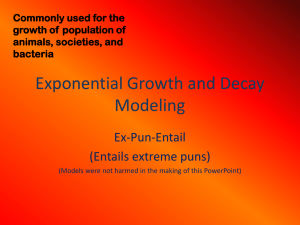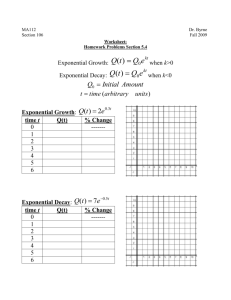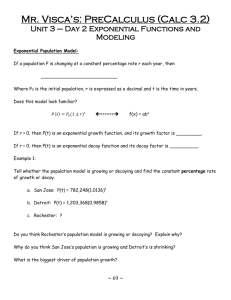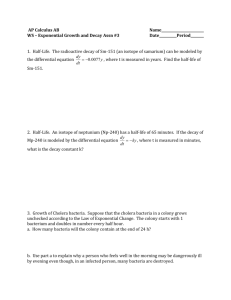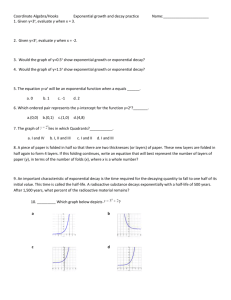PreCalc Section 4.5
advertisement
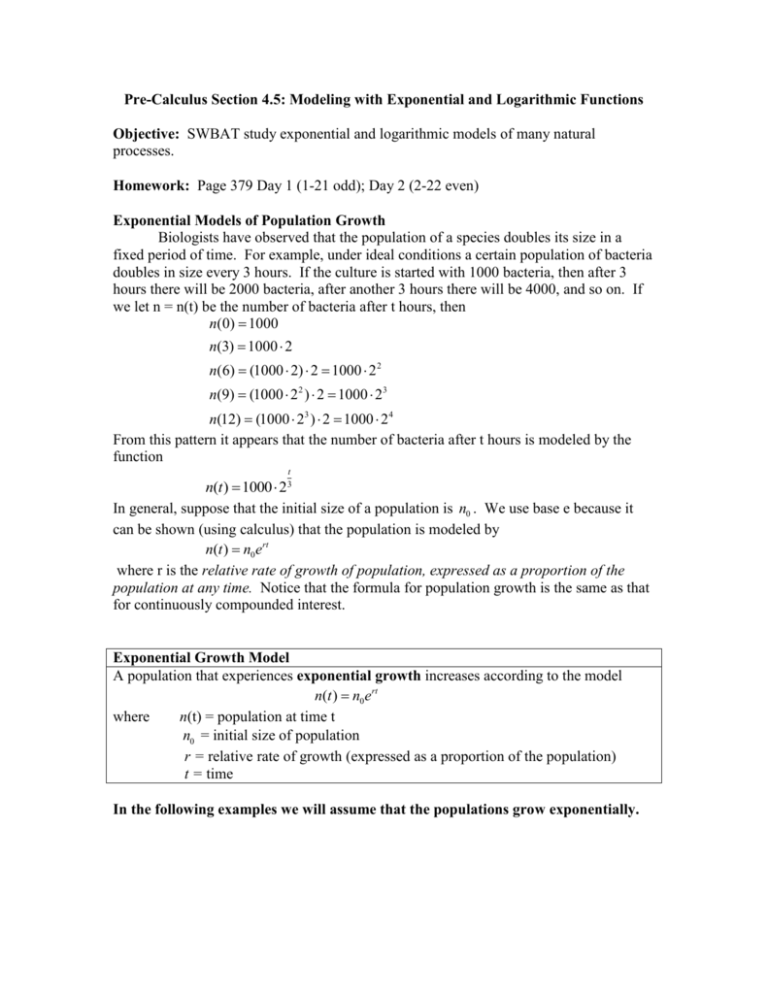
Pre-Calculus Section 4.5: Modeling with Exponential and Logarithmic Functions Objective: SWBAT study exponential and logarithmic models of many natural processes. Homework: Page 379 Day 1 (1-21 odd); Day 2 (2-22 even) Exponential Models of Population Growth Biologists have observed that the population of a species doubles its size in a fixed period of time. For example, under ideal conditions a certain population of bacteria doubles in size every 3 hours. If the culture is started with 1000 bacteria, then after 3 hours there will be 2000 bacteria, after another 3 hours there will be 4000, and so on. If we let n = n(t) be the number of bacteria after t hours, then n(0) 1000 n(3) 1000 2 n(6) (1000 2) 2 1000 2 2 n(9) (1000 2 2 ) 2 1000 23 n(12) (1000 23 ) 2 1000 2 4 From this pattern it appears that the number of bacteria after t hours is modeled by the function t 3 n(t ) 1000 2 In general, suppose that the initial size of a population is n0 . We use base e because it can be shown (using calculus) that the population is modeled by n(t ) n0e rt where r is the relative rate of growth of population, expressed as a proportion of the population at any time. Notice that the formula for population growth is the same as that for continuously compounded interest. Exponential Growth Model A population that experiences exponential growth increases according to the model n(t ) n0e rt where n(t) = population at time t n0 = initial size of population r = relative rate of growth (expressed as a proportion of the population) t = time In the following examples we will assume that the populations grow exponentially. Example 1: Predicting the Size of a Population. The initial bacterium count in a culture is 500. A biologist later makes a sample count of bacteria in the culture and finds that the relative rate of growth is 40% per hour. (a) Find a function that models the number of bacteria after t hours. (b) What is the estimated count after 10 hours? (c) Use your calculator to graph the function n(t). Example 2: Comparing Different Rates of Population Growth In 2000 the population of the world was 6.1 billion and the relative rate of growth was 1.4% per year. It is claimed that a rate of 1.0% per year would make a significant difference in the total population in just a few decades. Test this claim by estimating the population of the world in the year 2050 using a relative rate of growth of (a) 1.4% per year (b) 1.0% per year. (c) Graph the population functions for the next 100 years for the two relative growth rates in the same viewing rectangle. Example 3: Finding the Initial Population A certain breed of rabbit was introduced onto a small island about 8 years ago. The current rabbit population on the island is estimated to be 4100, with a relative growth rate of 55% per year. (a) What was the initial size of the rabbit population? (b) Estimate the population 12 years from now. Example 4: World Population Projections The population of the world in 2000 was 6.1 billion, and the estimated relative growth rate was 1.4% per year. If the population continues to grow at this rate, when will it reach 122 billion? Example 5: The number of Bacteria in a Culture A culture starts with 10,000 bacteria, and the number doubles every 40 min. (a) Find a function that models the number of bacteria at time L. (b) Find the number of bacteria after one hour. (c) After how many minutes will there be 50,000 bacteria? (d) Use your calculator to graph of the number of bacteria at time t. Radioactive Decay Radioactive substances decay by spontaneously emitting radiation. The rate of decay is directly proportional to the mass of the substance. This is analogous to population growth, except that the mass of radioactive material decreases. Physicists express the rate of decay in terms of half-life, the time required for half the mass to decay. Radioactive Decay Model If m0 is the initial mass of a radioactive substance with half-life h, then the mass remaining at time t is modeled by the function m(t ) m0e rt ln 2 where r . h Example 6: Radioactive Decay Polonium-210 ( 210 Po ) has a half-life of 140 days. Suppose a sample of this substance has a mass of 300mg. (a) Find a function that models the amount of the sample remaining at time L. (b) Find the mass remaining after one year. (c) How long will it take for the sample to decay to a mass of 200mg? (d) Graph the sample mass as a function of time.
